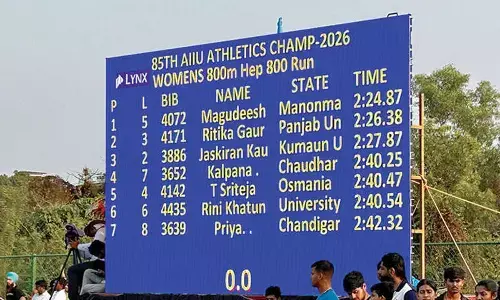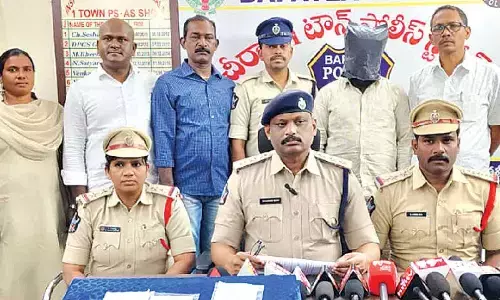How community-managed natural farming can fix broken food system

Natural farming system saves `12.3 lakh crore every year by way of costs that are avoided in managing degraded lands
Natural farming system saves `12.3 lakh crore every year by way of costs that are avoided in managing degraded lands
Several years ago, I requested the then Director General of the Indian Council of Agricultural Research (ICAR) to visit some villages in Andhra Pradesh where a unique community managed system, based on no application of chemical pesticides, was emerging as a new social movement.
He listened to me patiently, wanting to know more about how the concept of No-Pesticides Management (NPM) had caught up with farmers' imagination, so much so that the transformation towards a safe and healthy farming system was quietly expanding. I must acknowledge that soon after putting down the phone, he asked the Directorate of Research at Hyderabad to depute a team of scientists to visit a few villages to make a preliminary assessment. A couple of days later, he called up to say that the report he received showed positive and significant behavioural changes necessitating a shift from established farming practices.
Why I am narrating this story is to explain how early one could see the enormous possibilities the NPM system was likely to throw. It has taken several years, but it is heartening to know that what began as a small initiative is now being seen globally as a beacon of hope.
The Community Managed Natural Farming (CMNF) programme, as it is now called, has spread to 3,780 villages with more than 7,00,000 farmers in 13 districts showing the way. In fact, to the best of my understanding CMNF has emerged as probably the world's biggest agro-ecological farming system. So much so that the Global Alliance for the Future of Food has in its latest report True value: Revealing the positive impacts of food system transformation listed it among the six global initiatives that have the potential to fix the broken food systems, and thereby lay a foundation for a change the world is keenly looking forward to.
Using the True Cost Accounting methodology that was developed on the lines of what was suggested in the report of The Economics of Ecosystem Services of Biodiversity (TEEB) that the United Nations Environment Programme (UNEP) has perfected over the years; natural farming practices in Andhra Pradesh are now being practiced on 8,000,000 hectares. Operating under a decentralised farming system, the programme runs through a government-owned non-profit Rythu Sadhikara Smstha (RySS). With 12,500 village councils, each looking after a cluster of 2000 households, the success of the programme lies on a peer-to-peer approach where a locally-identified team of 3 lead farmers – a master farmer, a natural farming fellow, and an outreach extension specialist – advise and guide fellow farmers.
As the report acknowledges, the role women groups have played in incorporating natural farming principles in local society and culture is exemplary. If you have to know how women power can transform a society, you have to come and see how seven million women have formed 6,52,440 self-help groups, referred generally as 'spiritual capital" of the natural farming movement, have taken over decision-making. In my travels, I have always been left amazed by the sheer strength of women power, with these groups distributing loans, managing input supplies, organising storage and processing, and helping in knowledge dissemination. You have to be at the meetings of the self-help groups to know what steers the natural farming movement, and how they act as the pillar of strength.
Dr GV Ramanjaneyulu, Executive Director of the Centre for Sustainable Agriculture, Hyderabad, a passionate proponent of the NPM approach, and someone who believes in agro-ecological farming systems, had first taken me around to show the strength of women SHGs. Among the 38 NGOs engaged with the CMNF programme, CSA was the front-runner to have converted an entire village in Warangal district to not only go organic but also to form a cooperative. Since then six more such organic villages have come up.
With no chemical pesticides and reduced fertiliser application, the usual illness cases have dropped by 86 per cent and it has brought about a reduction in the health expenses an average of 50 per cent per household. Considering the increased medical expenses is one of the primary reasons behind increasing farm suicides in the country, the CMNF approach is probably the way forward to pull farmers out of the vicious debt trap. And let's not forget, with 68 per cent reduction in cost of cultivation and with 88 per cent farmers showing statistically significant increase in crop yields, farm income has increased from 8 to 111 per cent depending upon the kind of cultivation undertaken. But that does not mean, agro-ecological farming systems do not need income support.
These farmers need to be paid for environmental protection, and for their role in preserving ecosystem services. While crops need 55 per cent less water and electricity, resulting in 55 to 99 per cent lower emissions, the natural farming system has saved Rs 12.3-lakh crore every year by way of costs that are avoided in managing degraded lands. But what may be difficult to measure economically are the indirect but ever-lasting benefits that accrue. With 43 per cent farmers reporting an increase in earthworms, and 52 per cent reporting softened soils, and 36 per cent saying the green cover has increased, what I find fascinating is that 95 per cent people acknowledge that the food taste has improved, and with 70 per cent of the chemical-free food being consumed locally, the nutritious intake has also improved, including a remarked improvement in dietary fibres.
With Minister for Agriculture Kurasala Kannababu now promising a policy frame work for organic agriculture and natural farming, I am sure the numerous hiccups that CMNF encounters, including reports of non-payment of salaries to the staff, are immediately taken care of. The programme also requires more budgetary support to meet the target of converting the entire farming population go chemical free in the next few years.
Every successful transformation that the world has witnessed actually hinges around a powerful catalyst. While it was scientist-turned-environmentalist Parshu Ram Mishra in case of the Sukho-Majri model in the Shivalik hills in the mid-1980s, a senior bureaucrat Vijay Kumar Thillam, now retired and presently the co-chair of RySS, is the moving spirit behind the remarkable transition witnessed in Andhra Pradesh.
Taking up a challenge that is not only path-breaking, he has effectively brought about a transformation that should be viewed as what 'smart agriculture' means. That's a transformation that Andhra Pradesh should be proud of. And that's a transformation that provides a sustainable pathway for the future of food.
(The author is a noted food policy analyst and an expert on issues related to the agriculture sector. He writes on food, agriculture and hunger)

















